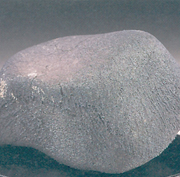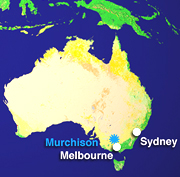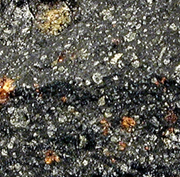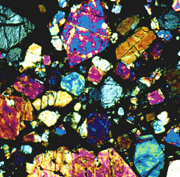Official Name:
Murchison is the name of the small village where the meteorite shower fell.
Location:
Murchison is about 130 kilometres north of Melbourne, in the state of Victoria, Australia.
Fall or Find:
Fall
Date:
28 September 1969, between 10:45 and 11:00 a.m., local time.
Mass Recovered:
100 kilograms of the Murchison meteorite have been recovered.
Number of Fragments:
About 700 stones fell in this shower. The largest fragment weighed 7 kilograms.
Strewn field:
The strewn field is rather small-it covers an area of only 13 square kilometres.
Circumstances:
It was a Sunday morning, and most of the residents of Murchison were on their way to church when the fireball crossed the sky. Several witnesses heard loud explosions and whistling sounds, then saw the fireball break into fragments. Hundreds of small stones resembling charcoal briquettes rained down on the village. Witnesses reported that an odour of methanol hung over the village following the fall. This odd odour was caused by hydrocarbons, and it revealed the presence of organic material in the meteorite. Murchison residents quickly began collecting the fragments after the fall. They gathered stones that fell in their yards and in neighbouring streets. The speed and care with which the fragments were collected minimized the danger of their being contaminated by the Earth.

Enlargement
Oriented fragment of the Murchison carbonaceous chondrite. The dark fusion crust has fine flow lines running over it. |
|

Enlargement
Murchison is in southeast Australia, outside Melbourne. |
|
History:
1969 was a special year for harvesting and studying rare extraterrestrial rocks. First, there was the Allende shower (a carbonaceous chondrite, which is rare); then lunar samples were brought back from the Moon by the Apollo 11 mission; and finally, the equally famous Murchison meteorite (another carbonaceous chondrite) fell to Earth.
Type:
Stony meteorite
Class:
Carbonaceous chondrite
Group:
CM2, the most common group of carbonaceous chondrites.
Composition:
Like all carbonaceous chondrites, Murchison is very primitive. Careful observation of its dark interior reveals numerous chondrules, as well as calcium-aluminium inclusions. Murchison also contains nanodiamonds, which account for 6% of the carbon contained in the meteorite. These tiny diamonds probably formed when a star exploded near the nascent solar system.
The meteorite also contains a large variety of organic compounds, including amino acids (which are biological in origin). Over the last thirty years, more than 92 different amino acids have been identified in this carbonaceous chondrite. Most of these amino acids have no terrestrial equivalent.
Murchison contains 12% water. This high proportion of hydrated minerals may indicate that the meteorite is debris from the nucleus of a comet. The presence of water in the meteorite makes it crumble easily-it is very fragile.

Enlargement
A fragment of the Murchison meteorite without its fusion crust. The chondrules and calcium-aluminum inclusions are visible. |
|

Enlargement
Large chondrules are rare in this meteorite. This one has a diameter of 0.9 millimetre. It is composed of olivine and has no boundary. |
|
Scientific contribution:
This meteorite transformed our understanding of organic material in the universe. Murchison proved that organic molecules can form in space, outside Earth's atmosphere. The Murchison carbonaceous chondrite raises an important question: Might the first amino acids-essential to life on Earth-have been imported by meteorites?
Part of the Planétarium's collection:
Yes